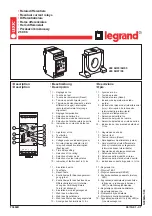
BE1-51/27R - Tests And Adjustments
5-13
NOTE
If Timing Type Z1, Z2, or Z3 is installed, refer to time overcurrent curve selection to obtain
the desired set of time overcurrent curves (see Figures 1-2 through 1-70). Then proceed
to Step 1, following.
If Timing Type Z1, Z2, or Z3 is not installed, determine the timing type from the model and
style number for a specific relay. Then select the appropriate timing curve (see Figures
1-2 through 1-70). Proceed to the following, Step 1.
Step 2.
Remove the Phillips-head screws from both sides of the unit and remove the front panel. See
Figure 2-1 for the location of the logic board and curve selector.
Step 3.
Select the desired curve. See Table 2-3 for the desired curve and selector position.
Step 4.
Re-install the front panel and the front cover.
Time Delay Selection
Step 1.
Referring to the appropriate time overcurrent characteristic curve, select the desired time delay on
the front panel TIME DIAL for the anticipated input overcurrent difference (multiples-of-pickup cur-
rent) from the selected time overcurrent pickup point as follows:
(Selected Pickup Point) - (Anticipated Input Overcurrent) = Overcurrent Difference from Pickup
Step 2.
Set the front panel TIME DIAL as follows:
a. On the appropriate curve, plot upward from the
multiples-of-pickup-current value until
the horizontal line opposite the desired time delay (
time-in-seconds) is reached. The
setting curve nearest the plot point should then be entered on the front panel TIME DIAL.
b. Using Figure 1-6 as an example, if the overcurrent is expected to be 4 times the pickup
point value and time delay of 4 seconds is desired, plot upward from the point 4 on the
multiples-of-pickup-current axis until the point 4 from the time-in-seconds axis is
crossed. The curve for a setting of 52 crosses the plot point and should be entered on the
front panel TIME DIAL.
c. For a lesser overcurrent difference from the pickup point, the time delay will be greater, so
that for a multiple of 3 times the pickup current, the time delay for the previous front panel
setting of 52 will be 5.8 seconds.
Neutral Time Delay Selection
Step 1.
Use the same characteristic curve used in the previous paragraph (
Time Delay Selection).
However, the
multiples-of-pickup current, time-in-seconds, and the resulting front panel
NEUTRAL TIME DIAL setting can differ.
Step 2.
Set the front panel NEUTRAL TIME DELAY as follows:
a. On the appropriate curve, plot upward from the
multiples-of-pickup-current value until
the horizontal line opposite the desired time delay (
time-in-seconds) is reached. The
setting curve nearest the plot point should then be entered on the front panel NEUTRAL
TIME DELAY.
Содержание BE1-51/27R
Страница 14: ...BE1 51 27R General Information 1 9 Figure 1 1 Style Number Identification Chart...
Страница 36: ...BE1 51 27R General Information 1 31 Figure 1 38 Timing Type E7 BS 142 Extremely Inverse Drawing No 99 1097...
Страница 54: ...2 2 BE1 51 27R Human Machine Interface Controls And Indicators Figure 2 1 Location of Controls and Indicators...
Страница 59: ...3 2 BE1 51 27R Functional Description Figure 3 1 Functional Block Diagram...
Страница 69: ...BE1 51 27R Installation 4 7 Figure 4 8 Typical Internal Diagram Sensing Input Type M or N...
Страница 76: ...4 14 BE1 51 27R Installation Figure 4 14 Relay Signals and Current Pickup Example For 3 Phase Fault XE 0 65 X D...






































